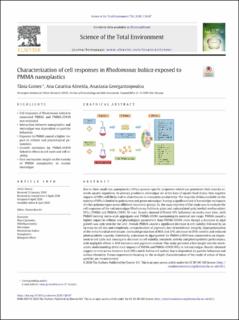| dc.contributor.author | Gomes, Tania | |
| dc.contributor.author | Almeida, Ana Catarina | |
| dc.contributor.author | Georgantzopoulou, Anastasia | |
| dc.date.accessioned | 2020-07-03T11:03:40Z | |
| dc.date.available | 2020-07-03T11:03:40Z | |
| dc.date.created | 2020-05-19T13:12:01Z | |
| dc.date.issued | 2020 | |
| dc.identifier.citation | Science of the Total Environment. 2020, 726, 138547. | en_US |
| dc.identifier.issn | 0048-9697 | |
| dc.identifier.uri | https://hdl.handle.net/11250/2660700 | |
| dc.description.abstract | Due to their small size, nanoplastics (NPLs) possess specific properties which can potentiate their toxicity towards aquatic organisms. As primary producers, microalgae are at the base of aquatic food chains, thus negative impacts of NPLs will likely lead to disturbances in ecosystem productivity. The majority of data available on the toxicity of NPLs is limited to polystyrene and green microalgae, leaving a significant lack of knowledge on impacts of other polymer types across different taxonomic groups. So, the main objective of this study was to evaluate the cell responses of the red microalgae Rhodomonas baltica to plain and carboxylated poly(methyl methacrylate) NPLs (PMMA and PMMA-COOH, 50 nm). Results showed different NPL behaviour in media over time, with PMMA forming micro-scale aggregates and PMMA-COOH maintaining its nominal size range. PMMA caused a higher impact in cellular and physiological parameters than PMMA-COOH, even though a decrease in algal growth was only seen for the later. Overall, PMMA caused a significant decrease in cell viability followed by an increase in cell size and complexity, overproduction of pigments, loss of membrane integrity, hyperpolarization of the mitochondrial membrane, increased production of ROS and LPO, decrease in DNA content and reduced photosynthetic capacity. Conversely, a decrease in algal growth for PMMA-COOH was connected to an impairment in cell cycle and consequent decrease in cell viability, metabolic activity and photosynthetic performance, with negligible effects in ROS formation and pigments content. This study provided a first insight into the mechanistic understanding of the toxic impacts of PMMA and PMMA-COOH NPLs in red microalgae. Results obtained suggest an interaction between both NPLs and R. baltica cell surface that is dependent on particle behaviour and surface chemistry. Future experiments focusing on the in-depth characterization of the mode of action of these particles are recommended. | en_US |
| dc.language.iso | eng | en_US |
| dc.publisher | Elsevier | en_US |
| dc.rights | Attribution-NonCommercial-NoDerivatives 4.0 Internasjonal | * |
| dc.rights.uri | http://creativecommons.org/licenses/by-nc-nd/4.0/deed.no | * |
| dc.title | Characterization of cell responses in Rhodomonas baltica exposed to PMMA nanoplastics | en_US |
| dc.type | Peer reviewed | en_US |
| dc.type | Journal article | en_US |
| dc.description.version | publishedVersion | en_US |
| dc.rights.holder | © 2020 The Authors | en_US |
| dc.source.pagenumber | 11 | en_US |
| dc.source.volume | 726 | en_US |
| dc.source.journal | Science of the Total Environment | en_US |
| dc.identifier.doi | 10.1016/j.scitotenv.2020.138547 | |
| dc.identifier.cristin | 1811693 | |
| dc.relation.project | Norges forskningsråd: 160016 | en_US |
| cristin.ispublished | true | |
| cristin.fulltext | original | |
| cristin.qualitycode | 2 | |

